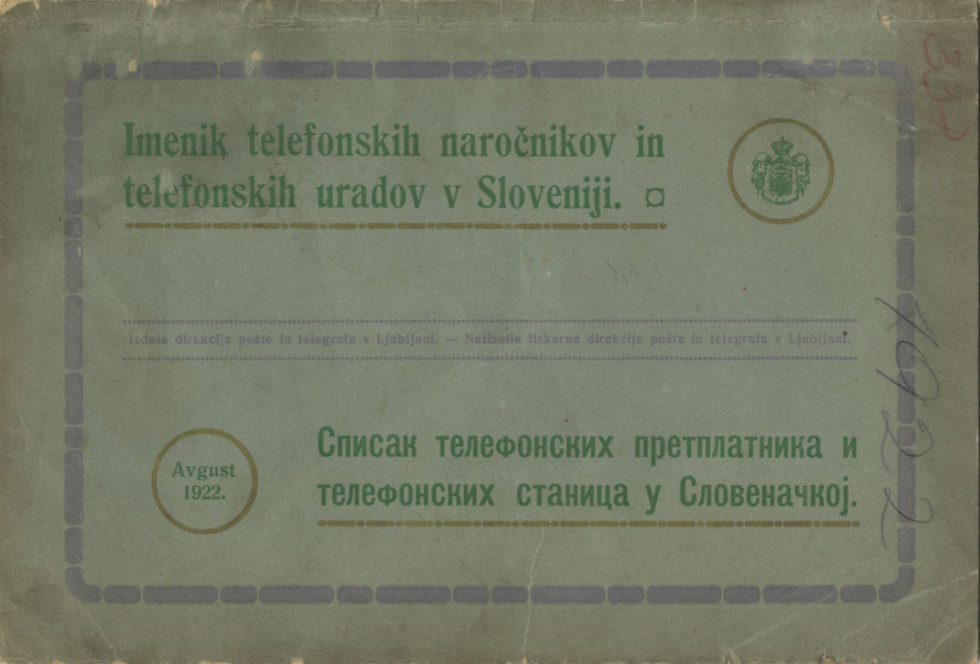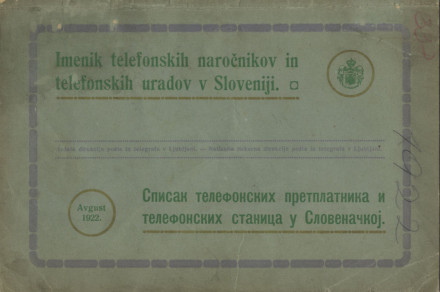Telephone in 99 Slovenian Towns a Century Ago
Directory of Telephone Subscribers and Telephone Offices for Slovenia
140 year ago, on February 14, 1876, Alexander Graham Bell turned to Boston Patent Office and applied for a patent for his device that could transmit speech and other voices by telegraph. Born to a deaf mother, this Scottish engineer, innovator and according to family tradition also the third-generation speech therapist, filed for the above mentioned patent for the simple reason of wanting to get his future father-in-law's permission to marry his deaf daughter. Bell is now revered as the inventor of electromagnetic telephone despite numerous affairs, lawsuits and attempts to prove otherwise by his contemporaries, who might have deserved that title more than Bell himself (A. Meucci, E. Gray). His first successful transmission was in March, followed in October by the first successful conversation at a distance of two miles between Boston and Cambridge. His »talking telegraph« was a sensation at the world exhibition in Philadelphia.
As early as December 1877, this novelty was tested in Slovenia as well; in Ljubljana, such apparatus was bought by the headmaster’s office of the Ljubljana secondary school (Realschule) especially for the purpose of testing, while in Maribor there was an unsuccessful attempt to transmit speech between telegraph stations in Graz and Klagenfurt. The first telephone line was installed in 1881 by the Ljubljana bell manufacturer Albert Samassa, connecting his office on the south side of the castle hill and the 140-metre remote bell factory in Zvonarska Street in the Prule district. In 1888, an internal telephone line was installed in a Maribor hospital to connect various departments. The invention of a telephone exchange by a Hungarian-born Tivadar Puskás in 1876 led to the formation of telephone networks. From June 1881 on, licences to set up private telephone networks were granted to individuals by the Austrian Ministry of Trade. Vienna got its own network in December 1881, Graz and Trieste in 1882, while in Ljubljana and Maribor there didn’t appear to be a sufficient interest for such implementation. In 1892, Austria-Hungary constructed 505 km long phone line, the longest in Europe, between Vienna and Trieste, but Austrian telephone service still could not keep up with the rest of Europe (in 1885, only one in 1050 inhabitants of Vienna owned a telephone, which is not a lot compared to Berlin, Paris and Rome where the number was one in 40). Due to unsatisfactory financial and technical output of the owners of the licences, the ministry eventually decided to repurchase licences. By the start of 1895, the entire telephone service was nationalized and included in the postal and telegraph administration.
The state invested heavily in communication infrastructure, particularly in the building of the premises needed for telephone exchanges. New postal and telegraph palaces were put up in Maribor (1894) and in Ljubljana (1896), followed by the implementation of the state phone networks in both of the mentioned cities. The networks began operating in the autumn of 1897 and were included in international telephone traffic. At the beginning there were only 66 subscribers in Ljubljana and 18 subscribers in Maribor, but within the next three years their number more than tripled (1901: Ljubljana 192, Maribor 68). The new postal building in Celje got its own exchange and phone booth in 1902.
By the end of WWI, telephone wires ran across the entire territory of Slovenia. They were first introduced in the Primorska region, and were most branched out in Styria.
Lists of telephone subscribers appeared immediately after the introduction of telephone networks. In 1881, six months prior to the opening of the exchange in Vienna, when the first official directory of telephone lines was published for the first time, some of the most distinguished owners of telephone lines in Vienna became the object of ridicule in the satirical review Kikeriki. “The Book of Fools”, as the list of telephone line owners in Berlin was jokingly referred to, was published that same years, accompanying the start of the operation of the telephone exchange in Berlin. Unfortunately, no such list could be found in Slovenia from this early period, when humorous mistrust of the newly introduced apparatus was still widely spread. The National and University Library in Ljubljana keeps the phone directory for Ljubljana for the years 1905 and 1920, and the Museum of Post and Telecommunications in Polhov Gradec keeps the 1911 directory for Trieste, Primorska and Carniola.
Presented as this month’s archivalia are glimpses of life from 99 Slovenian towns in 1922. As one can expect, Ljubljana had the highest number of telephones 568 (one per approximately 94 inhabitants), followed by Maribor 394 (one per 78 inhabitants), Celje 132, Ptuj 51 (one per 87 inhabitants), Kranj 30, Ljutomer 20, Murska Sobota 15, Bled and Lendava each 14, Tržič 13, Radgona 12, Žalec 11, Ormož, Rogaška Slatina, Središče ob Dravi, Škofja Loka and Vrhnika 10. The rest of the 21 Slovenian towns had 3 to 9 telephones, in 32 towns there were only one or two, and in 21 towns one could only make a phone call from a public phone booth.
Public phone booths were usually open from 8 am to 6 pm with two-hour break between noon and 2 pm. Open 24 hours a day were only booths in Maribor (at the central post office and at the central station), in Lendava, Gornja Radgona, Murska Sobota and Zidani Most. In Ptuj, Celje, Kranj, Tržič and Novo mesto the public phone booths were open from 7 am to 9 pm in the summer, and in the winter from 7 am to 8 pm, the so-called complete day service. The latter was also provided during high season in Bled, Rogaška Slatina and Rimske toplice. The people of Ljubljana could make phone calls non-stop from the public booth at the postal palace, and all day from the premises of present-day Archives of the Republic of Slovenia – Virant house (St. James Square, present-day Levstik Square 3), the seat of the Postal Direction and the Ljubljana Post 3. They could also place a call from the central station, but only during certain time of the day with the midday break.
General information about telephone subscribers can be gathered already from the directory’s introductory abstract of telephone rules. The rules divided subscribers in categories with different subscription fees and explained how these fees were calculated. They also explained how phone conversations were charged and included instructions on how to use a telephone – how loudly one must speak in the mouthpiece, when to pick up and when and where to hang up the receiver, how to state the phone number of a person you were trying to call, which then exchange needed to repeat etc (at the time telephones did not have dials and the calls were put through by operators in the exchange). Last but not least the rules also warned the reader against making phone calls during storms.
Going through the list of subscribers we can relive the images of the towns as they were then, especially the towns with higher number of telephone subscribers. In Ljubljana, telephones were used by civil and military authorities, by bodies of regional administration, by the town hall, its offices, companies and the mayor. Official postal telephones were a category unto itself. Telephones were owned by hospitals (general public hospital in Zaloška Street, maternity hospital, Leoninum sanatorium, Elizabetinum, lunatic asylum) and the “Zlati jelen” pharmacy, cultural institutions and schools (the cultural society Glasbena matica, opera house, drama theatre, the headmasters’ offices of the Ljubljana lyceum and Realschule, state vocational and blacksmith school) as well as political parties. Of course, most of the subscribers came from the field of economy – banks, savings banks and banks of exchange, insurance companies, factories, companies, manufacture and workshops, cooperative societies, import-export companies, wholesale business and merchants of all sorts, foreign trades and their representatives, newspapers, printing and bookbinding works, railroad and central stations. Also worth mentioning is the administration of tram company, the office for the Ljubljana Fair, and let’s not forget the hotels, coffeehouses, inns, the Narodni dom … we could go on and on. Perhaps we should just add that individuals, mostly those coming from the world of business, also owned telephones. Included among them were largely lawyers with their own law firms, bank directors, directors, important officials, engineers and professors; some of their private addresses corresponded to their business addresses and some did not. Where telephones were scarce, they were most commonly owned by gendarmerie and railway stations, as well as important business subjects and enterprising individuals.
Now let us stop discovering and let’s embark on the adventure and research the places and the people you know and love.
Aleksandra Mrdavšič



